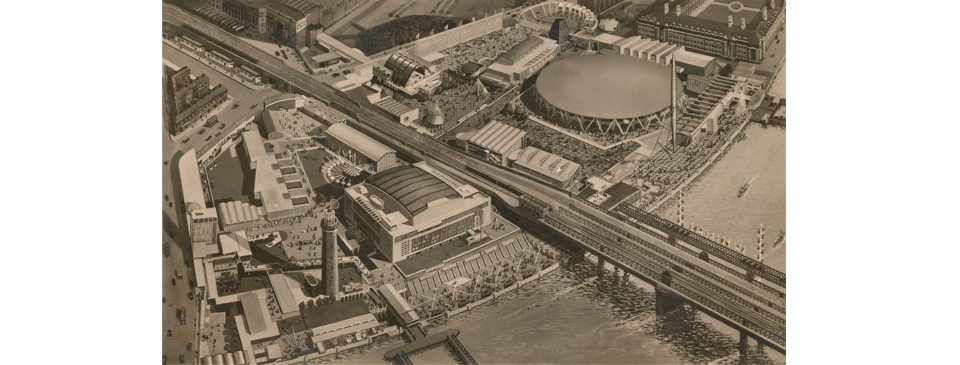The Festival of Britain – A Tonic To The Nation

The South Bank site of the Festival of Britain, as seen on a contemporary souvenir postcard. It clearly shows the two sections, divided by the Hungerford Bridge railway viaduct. The Dome of Discovery and Festival Hall dominate. Other notable features include the Shot Tower (lower left) and the tall Skylon.
Other parts of the Festival in London included a funfair and ‘pleasure gardens’ in Battersea Park, inspired by the former Vauxhall Pleasure Gardens. It was less thematic, more jovial than the South Bank area, and purely as entertainment. It almost didn’t happen due to much opposition, including from the Mayor of Lambeth. It was also where the Festival’s sculpture exhibition was held. Sculptors featured there and at the South Bank included Jacob Epstein, Henry Moore, Barbara Hepworth and Eduardo Paolozzi.
A separate section of the Festival was created in the basement of the Science Museum at South Kensington to present physics, chemistry, metallurgy, physiology and medicine in an engaging way.
In the aftermath of the war there was much rebuilding to be undertaken in London and elsewhere. The eminent town planner Sir Patrick Abercrombie had put forward grand plans to sweep away the old and replace with new, and to create ‘New Towns’ to which Londoners could migrate. A new generation of young architects were buzzing with ideas. Space within the South Bank site was too limited to adequately show those concepts. It was therefore decided that the London County Council should take over a 30-acre bomb-damaged area of Poplar in East London as part of the Festival and there create a ‘Live Architecture Exhibition’ to illustrate the latest ideas in community planning. A new neighbourhood, complete with housing, two churches, a school, and Chrisp Street market – London’s first shopping precinct – were built. It was named the Lansbury Estate after the late local MP George Lansbury. It was to be permanent and became a prototype for similar developments in towns across the country in the 1950s and ‘60s.
The Festival was opened by King George VI in a speech from a dais on the steps of St. Paul’s Cathedral on 3rd May 1951, in one of his last public appearances before his death the following year. A service took place within the cathedral, attended by the royal family and the great and the good of the country. The exhibitions opened to the public on the following day, the 4th May.
Away from the capital many institutions, towns and villages created their own events, ranging from firework displays to new sewage works, as part of the nationwide contribution. The list of such events ran to 160 pages in a Festival booklet. A mobile exhibition known as the ‘Land Traveller’ exhibition visited four provincial cities. The aircraft carrier Campania, on loan from the Royal Navy, was fitted out with yet another exhibition that sailed around the coast to the nation’s ports. At Glasgow there was the Industrial Power Exhibition and in Belfast the Farm and Factory Exhibition.
The Festival was only intended to be temporary. Morrison preferred not to pre-determine a date for its closing but eventually decided 30th September. It had lasted for almost five months and in many ways was a great success. Eight and a half million people paid to visit during that time, with as many as 100,000 in a single day. Having seen the pre-publicity, people arrived already expecting to be both entertained and educated.
A month after the Festival ended the Labour Party lost the general election. Responsibility passed to the Conservative Minister of Works, who took no time in demolishing almost all structures on the South Bank. The Skylon and Dome of Discovery were sold for scrap, despite proposals to move the latter elsewhere, and the shot tower was finally demolished in 1962. Herbert Morrison became a life peer in 1959 as Lord Morrison of Lambeth.
The 3,000 seat Royal Festival Hall was the only part that remained after the event ended and continues to be one of the city’s leading concert venues. It became the catalyst for the creation of the South Bank arts complex, being later joined by the Hayward art gallery and Purcell Room in the 1960s, the National Theatre in 1976, the smaller Queen Elizabeth Hall, and the National Film Theatre. The Shell Centre was another prominent building that filled the space after the Festival ended. The London Eye Ferris wheel opened in 2000. The South Bank of today, which continues as a vibrant place for Londoners and tourists to stroll, still maintains the atmosphere seen in photographs of the Festival.
To a nation more familiar with drabness the Festival provided the optimistic impression that Britain was recovering, with the hope of a bright and colourful future. It made people believe things could get better. During the summer of 1951 it was the most exciting place in London. Its vision was in line with the 1950s concepts of the Welfare State and National Health Service, pedestrian precincts, community centres, council housing, high rise buildings, and espresso bars.
The Festival showcased modern British design and style, much of it conceived prior to the war but not previously seen by the general public, incorporating ideas from Scandinavia and Italy, of Bauhaus, Mies van der Rohe, and Frank Lloyd Wright. The reputations of a new generation of designers and architects was established, including the young Terence Conran. Its lasting legacy was in the planning of New Towns of the ‘50s, such as Harlow – which was conceived by men who worked on the Festival – and the rebuilding of old towns such as Coventry.
Sources include: ‘A Tonic To The Nation – The Festival of Britain 1951’ ed. Mary Banham and Bevis Hillier; John Richardson ‘The Annals of London’; Jerry White ‘London in the 20th Century’; Hannah Renier ‘Lambeth Past’; Talk given by Naomi Games, April 2021, 20th Century Society; ‘A London Inheritance’ blog https://alondoninheritance.com;
